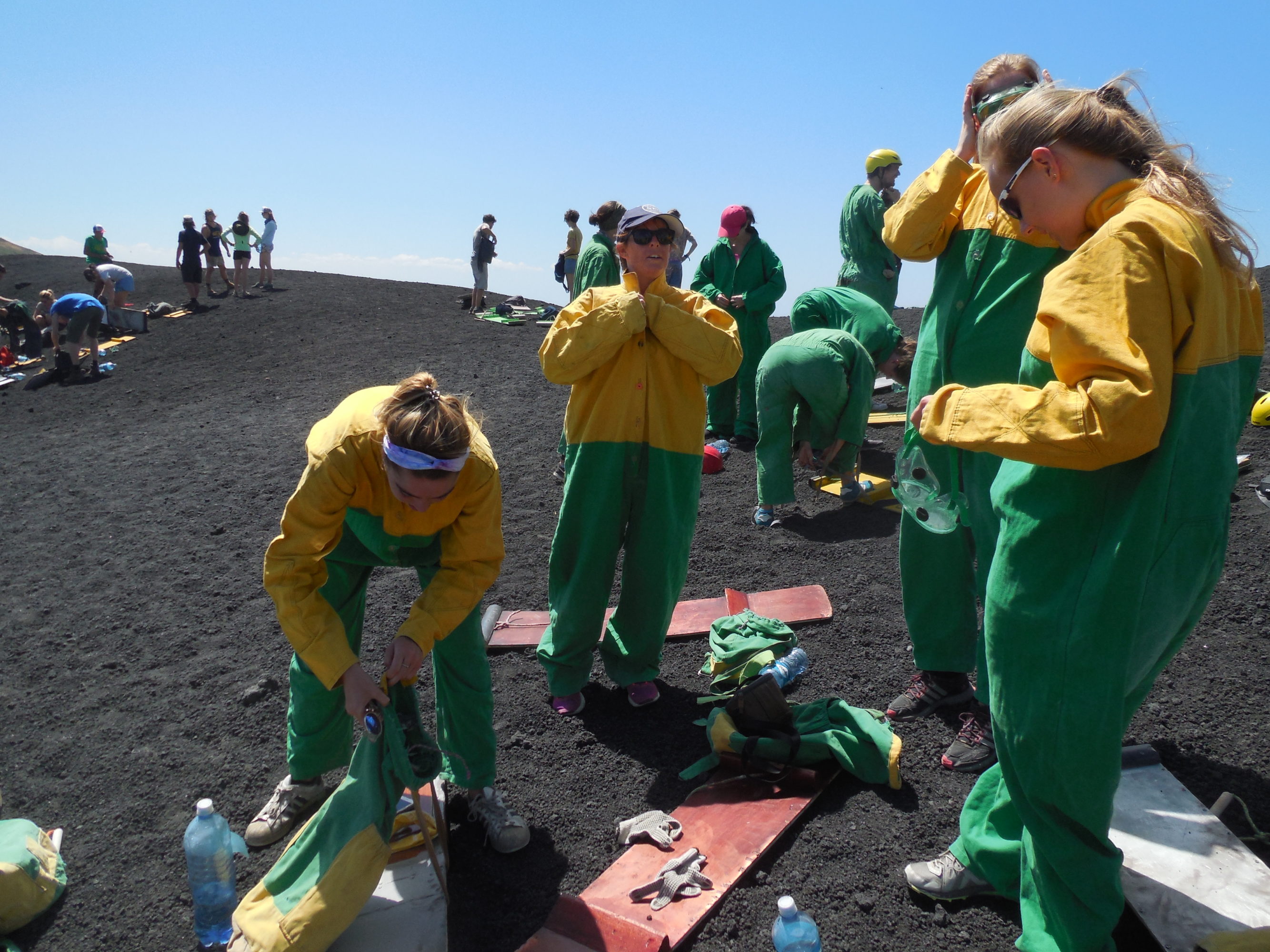Dominique van de Kamp is a Master student Anthropology at the VU and is currently writing her thesis about volcano tourism in León, Nicaragua, known as ‘the land of lakes and volcanoes’. She is sharing a story about one of her days in the field, and how volcanoes can be both destructive and contribute to the economy.
León, the former capital of Nicaragua, was destroyed in 1610 due to an eruption of the nearby Momotombo volcano. The city was relocated, but remained close to the volcanic chain Cordillera los Maribios. Two centuries later and only 25 km away, Cerro Negro was born, one of the most active volcanoes in Central America. Ironically, locals found out how to exploit this volcano and it became the main tourist attraction of León: the first place in the world where you can surf down the slopes of an active volcano. Though this might seem insane to some, it tops every list of ‘Things to do in Nicaragua’.
In León, there is no need to set an alarm. The city sirens set off every morning at 7am sharp, indicating it is time for school or work. By this time I am awake, and it is already warm. My rusty fan has been off for hours, and I realise that there has been a power cut during the night. I take a refreshing shower with cold water from a small iron pipe, and put on the same clothes as the day before. I unlock my heavy front door and enter the street, where I spot the sun high on the horizon. Buildings in León are not allowed to rise above the cathedral, and I believe this is related to earthquakes. My home is easy to find, the address is ‘one block east from the yellow church, then three and a half blocks up north’. I live near parque San Juan, where street vendors sell meaty street food, fresh fruit, and random things such as power strips, padlocks and backpacks. Elderly people relax in their rocking chairs, blocking the small sideways between their front doors and the streets. The sun is very unforgiving; I always longed for a bicycle, until I borrowed one for a day and found out the sun is inescapable in the middle of the road. Therefore people follow the shade, constantly crossing the streets. At my favourite coffee place I order a café pequeño and a typical Nicaraguan breakfast; a plate of mixed rice and beans, rubbery white cheese, fried banana and two slices of baguette with an egg. The place has one of the best Wi-Fi connections in town and I start to work out some of my field notes.
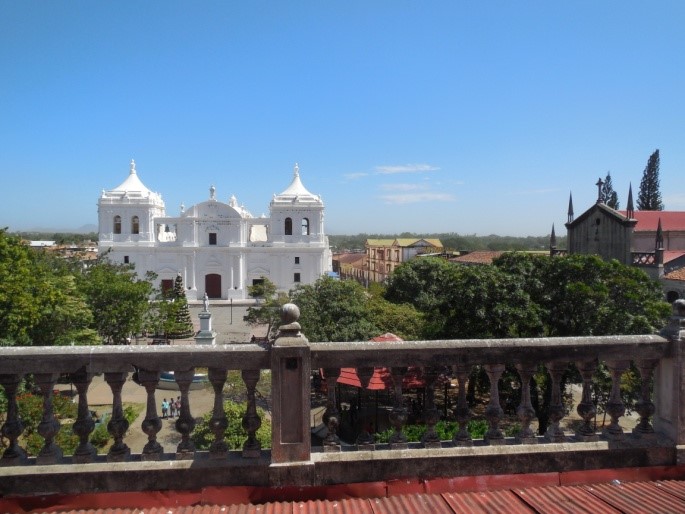
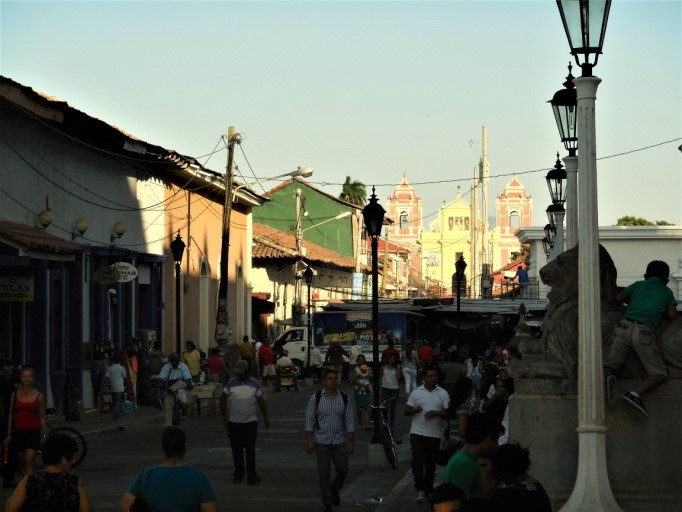
The sirens ring again at noon, indicating lunchtime. I find that it is an interesting way of structuring the day, as most people are not that punctual in Nicaragua, and are easygoing. After noon, it becomes too hot to focus. Before I get out, I refill my bottle with water from the tap and walk two blocks to one of the tour operators I work with, and with whom I am collecting data for my thesis. My work on volcano tourism in León is focused on tour guides, who are engaged in emotional labour. This afternoon, I am doing participant observation on Cerro Negro.
The ‘Black Hill’ is the youngest volcano in Central America, but has already erupted over 20 times, of which the last serious eruption was triggered by an earthquake in 1999. The eruption resulted in an outburst of sizzling black ashes from the cone, while leaking boiling magma from the cracks in the slopes. It lasted almost two days and left the surrounding, evacuated areas in the dark. During that time, the city mainly drew foreign visitors with its historic and colonial city centre, featuring the largest, flawlessly white cathedral of Central America. Roughly 15 years later, the destructive black hill has ironically transformed into one of the country’s most famous landmarks. The number of tourists increases every year, radically improving the economic situation of Nicaragua.
 During my stay, I have seen many travelers with nasty marks on their faces and the regular broken wrist, shoulder or ankle as a result from boarding down. When my time came, I deliberately destroyed my fancy running shoes by burying my feet down in the volcanic sand, trying to keep control of my board. After that adventure, I felt quite content with taking the group’s pictures whilst running down the slopes, which is an adventure as well. The windy hike up the volcano takes approximately 45 minutes. Surfing down can be done in 1-3 minutes, depending on your need for speed. Boarders carry their own boards made out of plywood and a plate of metal that breaks the friction. The board is strapped between their back and backpack, which also includes protective goggles, gloves and a gigantic colourful onesie. For many tourists, the resulting photos guarantee an unforgettable experience in itself and guides are compelled to take the best shot of participants in action.
During my stay, I have seen many travelers with nasty marks on their faces and the regular broken wrist, shoulder or ankle as a result from boarding down. When my time came, I deliberately destroyed my fancy running shoes by burying my feet down in the volcanic sand, trying to keep control of my board. After that adventure, I felt quite content with taking the group’s pictures whilst running down the slopes, which is an adventure as well. The windy hike up the volcano takes approximately 45 minutes. Surfing down can be done in 1-3 minutes, depending on your need for speed. Boarders carry their own boards made out of plywood and a plate of metal that breaks the friction. The board is strapped between their back and backpack, which also includes protective goggles, gloves and a gigantic colourful onesie. For many tourists, the resulting photos guarantee an unforgettable experience in itself and guides are compelled to take the best shot of participants in action.
At the top, we are rewarded with a panoramic view of some of the other volcanoes. It is usually clear enough to see the fuming mouth of Telica and the perfect cone of the country’s highest volcano; San Cristóbal. At the edge of Cerro Negro itself, we look down the quiet crater, biding its time. This might not be long, as another eruption is expected in the near future. The steep slope, reaching 40 degrees on the outer side, is the ‘drop zone’. Ashes come circling up where people are sledding down. It’s Boarding time! We give our group clear instructions of how to maintain balance and control the speed, and tell them to keep their mouths shut during the ride to avoid eating ash. Some people have a bumpy ride, somersaulting down the volcanic rocks. Some reach 70 km/h without any flaws, holding tight to their rope handles. Fortunately, everyone arrives down safe and sound. Lucky for them and lucky for us.
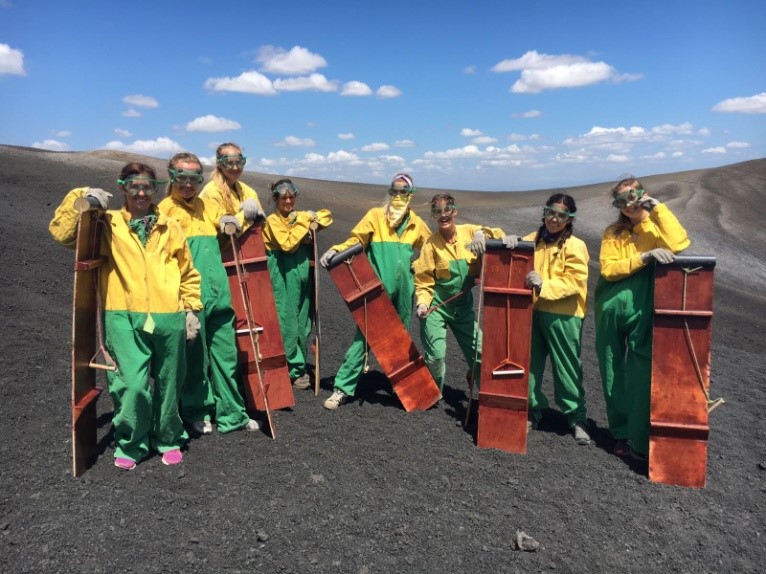
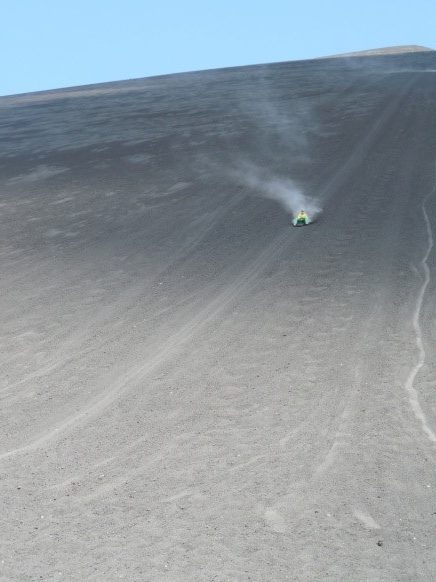
This is a once (or twice)-in-a-lifetime experience for tourists, but to many guides this is another day at the office. One of them explains: “… to be a guide is not just to show the way. The point is to show people what they would not see or experience without you. Everyone can find the way up Cerro Negro, so you provide extra information, show them why this is something impressive and how to board down safely. It is a success if you feel that without you, they would not have done the same thing.”
On the way back, the group is tired but excited, adrenaline still rushing through their veins. We get to León just after sunset, around 6pm. When the sun touches the Pacific Ocean, it takes less than three minutes before it disappears completely. However, this is when the magic begins. Pink, red and orange colours paint the sky. A welcome breeze fills the streets. As the world finally starts to cool down, all that is missing is a cold Toña beer.
